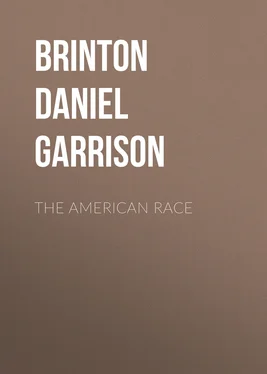Daniel Brinton - The American Race
Здесь есть возможность читать онлайн «Daniel Brinton - The American Race» — ознакомительный отрывок электронной книги совершенно бесплатно, а после прочтения отрывка купить полную версию. В некоторых случаях можно слушать аудио, скачать через торрент в формате fb2 и присутствует краткое содержание. Жанр: foreign_antique, История, История, foreign_edu, на английском языке. Описание произведения, (предисловие) а так же отзывы посетителей доступны на портале библиотеки ЛибКат.
- Название:The American Race
- Автор:
- Жанр:
- Год:неизвестен
- ISBN:нет данных
- Рейтинг книги:4 / 5. Голосов: 1
-
Избранное:Добавить в избранное
- Отзывы:
-
Ваша оценка:
- 80
- 1
- 2
- 3
- 4
- 5
The American Race: краткое содержание, описание и аннотация
Предлагаем к чтению аннотацию, описание, краткое содержание или предисловие (зависит от того, что написал сам автор книги «The American Race»). Если вы не нашли необходимую информацию о книге — напишите в комментариях, мы постараемся отыскать её.
The American Race — читать онлайн ознакомительный отрывок
Ниже представлен текст книги, разбитый по страницам. Система сохранения места последней прочитанной страницы, позволяет с удобством читать онлайн бесплатно книгу «The American Race», без необходимости каждый раз заново искать на чём Вы остановились. Поставьте закладку, и сможете в любой момент перейти на страницу, на которой закончили чтение.
Интервал:
Закладка:
We are obliged, therefore, to look for the original home of the American glacial man elsewhere than in America. Some interesting geological facts throw an unexpected light upon our investigations. I have already remarked that in the various recent oscillations of the earth’s crust, there occurred about the middle and later Glacial Epoch an uplift of the northern part of the continent and also of the northern Atlantic basin. In the opinion of Professor James Geikie this amounted to a vertical elevation of three thousand feet above the present level, and resulted in establishing a continuous land connection between the higher latitudes of the two continents, which remained until the Post-glacial period . 22 22 Quoted by G. F. Wright in The Ice Age in America , p. 583.
Dr. Habernicht also recognizes this condition of affairs and places it during the “old stone” age in Europe, 23 23 H. Habernicht, Die Recenten Veränderungen der Erdoberfläche , s. 27 (Gotha, 1882). He further shows that at that time both northern Russia and northern Siberia were under water, which would effectually dispose of any assumed migration by way of the latter.
which corresponds to the position assigned it by McGee.
Very recently, Professor Spencer has summed up the evidence in favor of the elevation of the northern portions of America and the north Atlantic, about the early Pliocene times, and considers that it proves beyond a doubt that it must have reached from 2000 to 3000 feet above the present level. 24 24 J. W. Spencer, in the London Geological Magazine , 1890, p. 208, sqq.
Further testimony to the existence of this land bridge is offered by the glacial striæ on the rocks of Shetland, the Faroe Islands, Iceland and south Greenland. These are in such directions and of such a character that Mr. James Croll, a high authority, maintains that they must have been produced by land ice , and that the theory of a land connection between these localities “can alone explain all the facts.” 25 25 James Scroll, Climate and Time , p. 451.
A comparison of the flora and fauna in the higher latitudes of the two continents reveals marked identities which require some such theory to explain them. Thus, certain species of land snails occur both in Labrador and Europe, and the flora of Greenland, although American in the north, is distinctly European in the south. 26 26 G. F. Wright, The Ice Age in North America , pp. 582-3 (New York, 1890). De Mortillet, Le Préhistorique , etc., pp. 186-7. H. Rink, in Proc. of the Amer. Philos. Society , 1885, p. 293.
Again, in certain very late Pliocene formations in England, known as the Norwich crag and the red crag of Suffolk, “no less than eighteen species of American mollusca occur, only seven of which still live on the Scandinavian coast, the remainder being confined to North America.” In consequence of such facts the most careful English geologists of to-day hold that the land communication, which certainly existed between Europe and North America in Eocene times by way of Iceland and Greenland, which was then a part of the American continent, continued to exist through the Miocene and Pliocene Epochs. This land bridge formed a barrier of separation between the Arctic and Atlantic oceans, so that the temperature of the higher latitudes was much milder than at present. 27 27 In his excellent work, The Building of the British Isles , (London, 1888), Mr. A. J. Jukes-Browne presents in detail the proofs of these statements, and gives two plates (Nos. XII. and XIII.), showing the outlines of this land connection at the period referred to (pp. 252, 257, etc.).
The evidence, therefore, is cumulative that at the close of the last Glacial Epoch, and for an indeterminate time previous, the comparatively shallow bed of the North Atlantic was above water; and this was about the time that we find men in the same stage of culture dwelling on both its shores.
The attempt has often been made by geologists to calculate the remoteness in time of the close of the Ice Age, and of these vestiges of human occupation. The chronometers appealed to are the erosion of river valleys, especially of the gorge of Niagara, the filling of lake beds, the accumulation of modern detritus, etc. Professor Frederick Wright, who has studied the problem of the Niagara gorge with especial care, considers that a minimum period of twelve thousand years must have elapsed since its erosion began. 28 28 Wright, The Ice Age , p. 504.
But as Professor Gilbert justly remarks, whatever the age of the great cataract may be, the antiquity of man in America is far greater, and reaches into a past for which we have found no time-measure. 29 29 Gilbert, Sixth An. Rep. of the Com. of the N. Y. State Reservation , p. 84 (Albany, 1890).
The same may be said for Europe. De Quatrefages and many other students of the subject consider that the evidence is sufficient to establish the presence of man near the Atlantic coast in the Pliocene Epoch; and excellent English geologists have claimed that the caves in the valley of the River Clwyd, in north Wales, whose floors contain flint implements, had their entrance blocked by true glacial deposits, so that man was there present before the Great Ice Age began.
From this brief presentation of the geologic evidence, the conclusion seems forced upon us that the ancestors of the American race could have come from no other quarter than western Europe, or that portion of Eurafrica which in my lectures on general ethnography I have described as the most probable location of the birth-place of the species. 30 30 Races and Peoples , chapter III. (David McKay, Philadelphia.)
Scheme of the Age of Man in America.

Many difficulties present themselves in bringing these periods into correspondence with the seasons of the Quaternary in Europe; but after a careful study of both continents, Mr. W. J. McGee suggests the following synchronisms: 31 31 “Palæolithic Man in America” in Popular Science Monthly , Nov., 1888.

Of course it would not be correct to suppose that the earliest inhabitants of the continent presented the physical traits which mark the race to-day. Racial peculiarities are slowly developed in certain “areas of characterization,” but once fixed are indelible. Can we discover the whereabouts of the area which impressed upon primitive American man—an immigrant, as we have learned, from another hemisphere—those corporeal changes which set him over against his fellows as an independent race?
I believe that it was in the north temperate zone. It is there we find the oldest signs of man’s residence on the continent; it is and was geographically the nearest to the land-areas of the Old World; and so far as we can trace the lines of the most ancient migrations, they diverged from that region. But there are reasons stronger than these. The American Indians cannot bear the heat of the tropics even as well as the European, not to speak of the African race. They perspire little, their skin becomes hot, and they are easily prostrated by exertion in an elevated temperature. They are peculiarly subject to diseases of hot climates, as hepatic disorders, showing none of the immunity of the African. 32 32 “No one could live among the Indians of the Upper Amazon without being struck with their constitutional dislike to heat.” “The impression forced itself upon my mind that the Indian lives as a stranger or immigrant in these hot regions.” H. W. Bates, The Naturalist on the Amazon , Vol. II., pp. 200, 201.
Furthermore, the finest physical specimens of the race are found in the colder regions of the temperate zones, the Pampas and Patagonian Indians in the south, the Iroquois and Algonkins in the north; whereas, in the tropics they are generally undersized, short-lived, of inferior muscular force and with slight tolerance of disease. 33 33 See E. F. im Thurn, Among the Indians of Guiana , pp. 189, 190, who speaks strongly of the debility of the tropical Indians.
Интервал:
Закладка:
Похожие книги на «The American Race»
Представляем Вашему вниманию похожие книги на «The American Race» списком для выбора. Мы отобрали схожую по названию и смыслу литературу в надежде предоставить читателям больше вариантов отыскать новые, интересные, ещё непрочитанные произведения.
Обсуждение, отзывы о книге «The American Race» и просто собственные мнения читателей. Оставьте ваши комментарии, напишите, что Вы думаете о произведении, его смысле или главных героях. Укажите что конкретно понравилось, а что нет, и почему Вы так считаете.












